Back to blog
5 MIN READ
How to Figure Out Why Your Apps Keep Crashing
PUBLISHED
22 August, 2024

Product Analytics Expert
Looking for data-informed answers to "why do my apps keep crashing?"
App crashes can have a huge negative effect on users’ experiences. Imagine browsing your feed on Instagram or Twitter and all of the sudden, it crashes. That can be extremely frustrating, so you don’t want to replicate that experience for your app’s users.
This doesn’t just frustrate users, it also affects your business. If your app crashes, your visibility and conversion rates will both suffer. So too will your reputation, as customers begin to see your app and business as not being responsive enough to their needs.
Ideally, you want to stop this before it happens. In this UXCam guide, you’ll learn one of the first layers of resolutions for apps crashing: how to figure out why they crash in the first place. Let’s begin.
Helpful Summary
Overview: This article focuses on identifying the causes of app crashes and provides strategies to prevent them.
Why you can trust us: UXCam has helped businesses and app developers by providing ways to analyze user interactions and detect issues, including app crashes.
Why it matters: Understanding and fixing app crashes is important for improving the user experience, maintaining engagement, and preventing revenue loss.
Action points: Use crash logs, reproduce crashes, check for memory leaks, review third-party libraries, and implement solid error handling to diagnose and fix app crashes.
Further research: Explore advanced debugging techniques, user feedback analysis, and continuous integration practices for app maintenance on the UXCam blog.
Why listen to us?
We've helped several businesses and app developers fix issues encountered by their app users, including crashes. UXCam allows you to automatically capture and analyze user interactions to detect crash patterns and other technical issues. This detailed insight helps you address and fix these problems promptly, ensuring a better user experience.
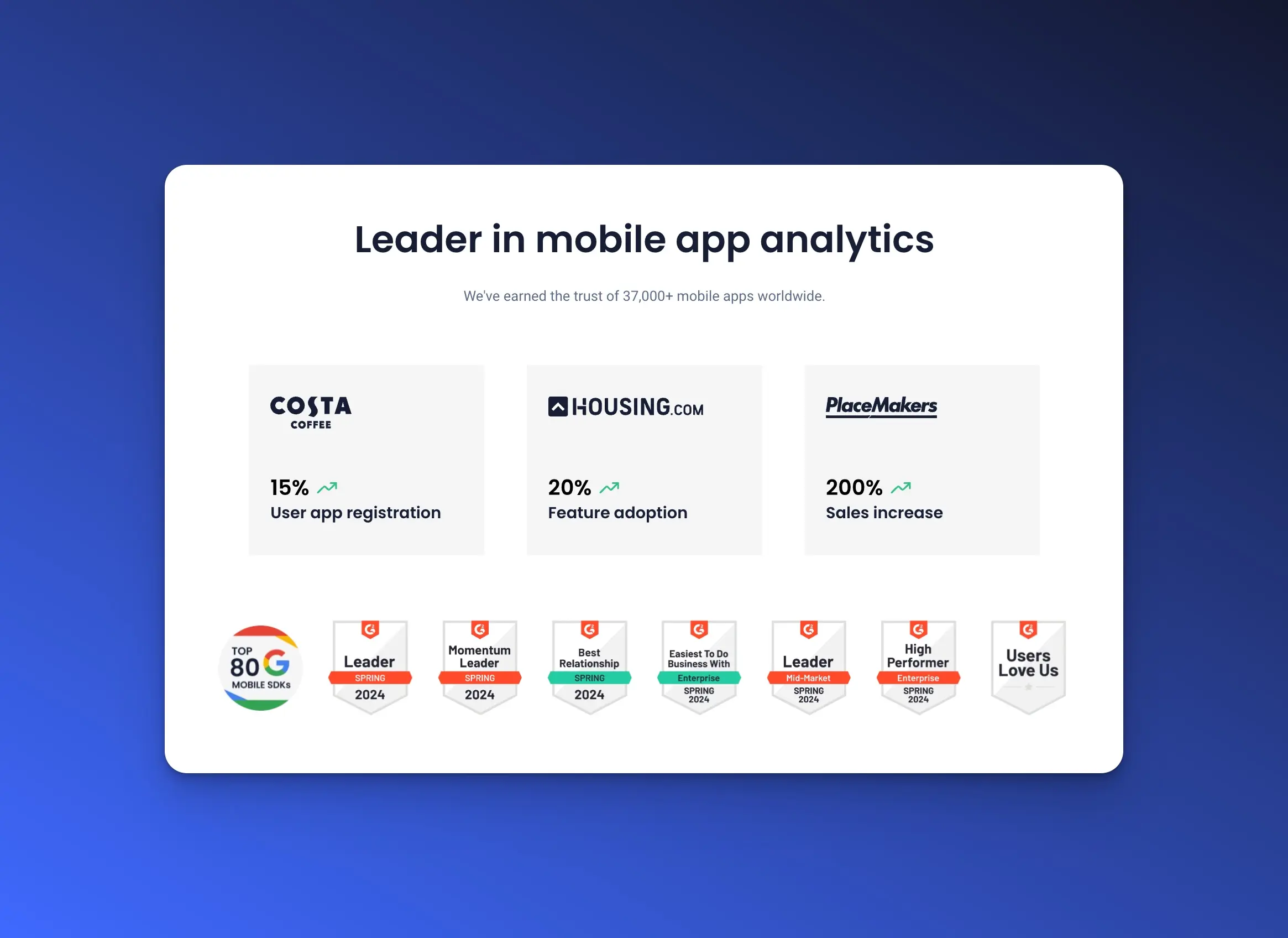
What are the main reasons for app crashes?
Crashes can broadly be categorized into two groups: crashes caused by user-related issues and crashes caused by developer-related issues.
1. Developers failing to test apps on real mobile devices
Developing apps requires financial investment. However, due to budget constraints, developers often fail to test the apps on real devices and platforms. This results in unexpected crashes if the user accesses the app via a device not included in the test.
Our tool, UXCam, can help developers test whether their app is usable for its end-users. You can access tons of quantitative and qualitative data based on your user’s interactions and gestures. Our session replay, heatmaps, and segmentation functionality show you your customer’s experience from their perspective. We also highlight behavior trends and patterns for a 360-degree understanding of your app’s usability. This means you can see how your app performs on a tablet, mobile phone, or other device.
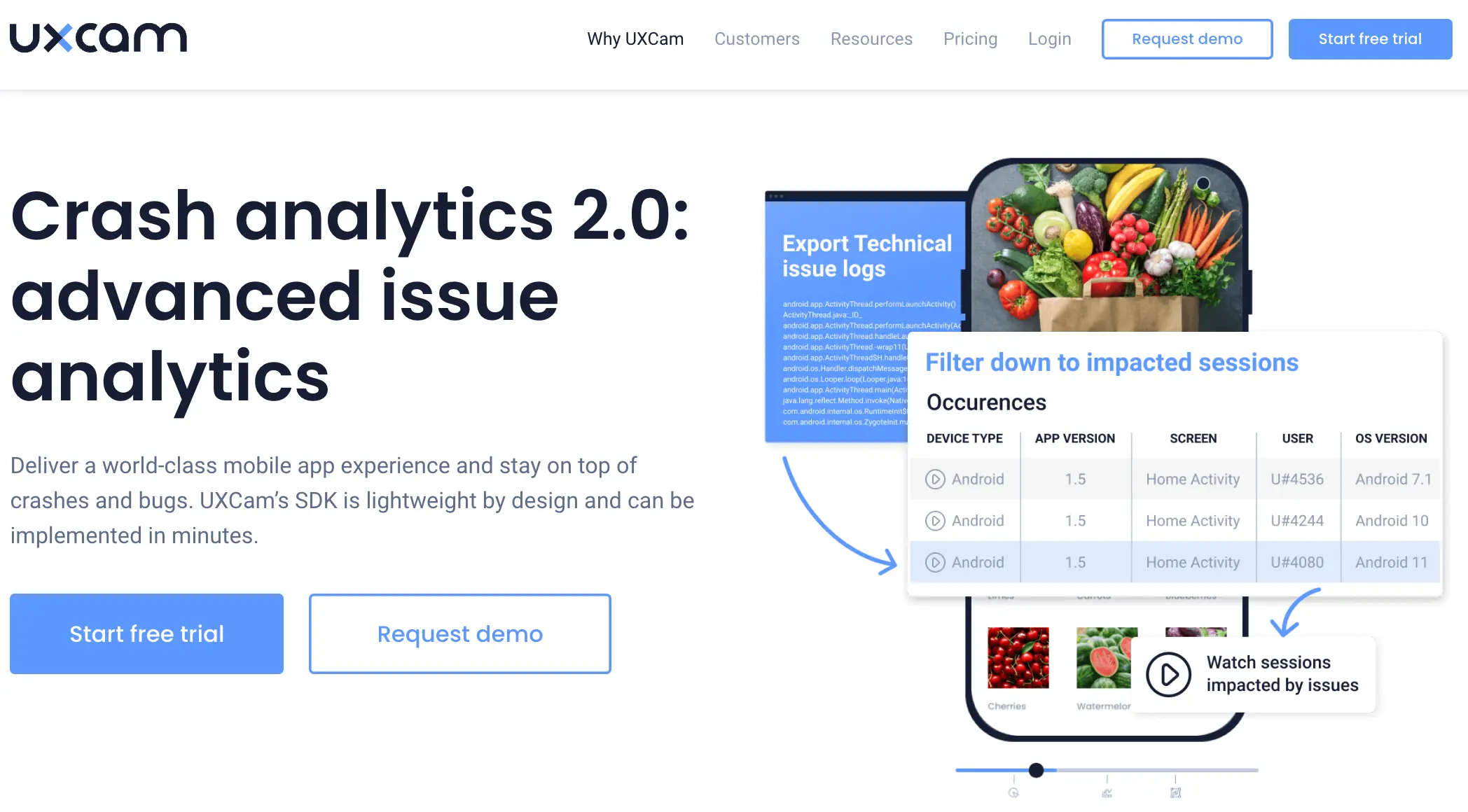
2. Customers using the app with poor network connectivity
As a developer, you may have successfully tested your app’s performance over a stable Wi-Fi connection. But, if an end-user accesses the app in poor network conditions, it may crash or freeze.
A classic example of this is when a user launches their app while inside an elevator, where there’s often unstable network connectivity.
3. Developers building applications with bad memory management
Apps can also crash if a user has limited memory usage. While this is partially the user’s responsibility, it’s on developers to make sure that their apps are as memory-efficient as possible. If your app consumes excessive memory in the background, an app crash or freeze will occur.
4. Infrequent app updates
Regularly updating your app isn’t just about releasing new features or updates, it’s also about preventing crashes from occurring.
Facebook is a prime example of a business that regularly updates its mobile app and introduces new features to maintain user engagement and improve security. The company frequently releases updates to address bugs, improve performance, and add new functionalities.
At UXCam we can help with in-app updates by providing valuable insights and analytics that can aid your update decisions. For instance, using our tool, you can track specific events within your app to understand user behavior and identify problems. This detailed analysis can guide the development of updates targeted at fixing exact issues that users face.
How can you figure out why your apps are crashing?
Here are proven ways that can help you figure out why your apps are crashing.
1. Check crash logs
Checking crash logs is the first step in identifying the root cause of an app crash. Crash logs provide detailed information about where and why the crash occurred.
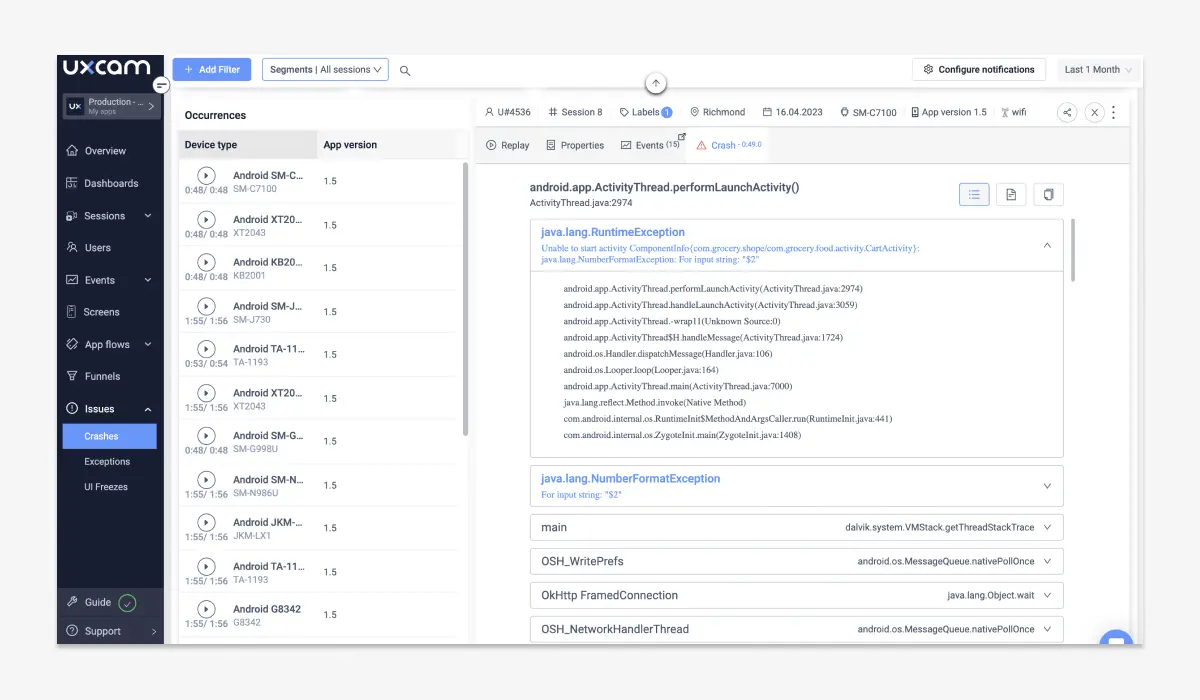
2. Reproduce the crash
Reproducing a crash is a great way to see what’s causing it and figure out how it can be fixed.
Specifically, you must be able to identify the steps leading to the crash and try to replicate it on different devices and operating system versions. This helps to confirm whether the issue is device-specific, OS-specific, or a more general problem.
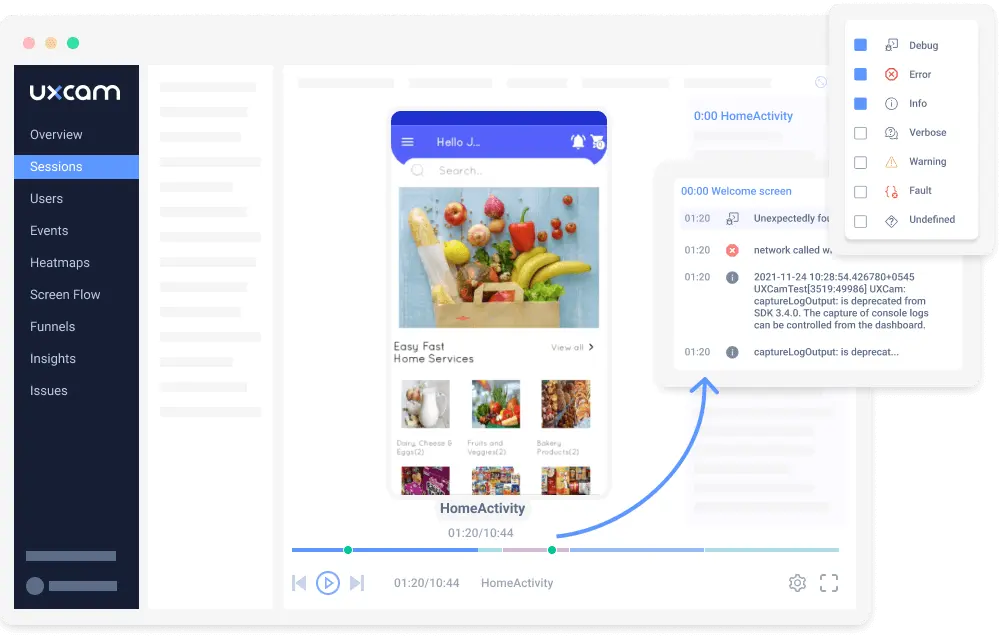
A notable example of a business that successfully reproduced an app crash to resolve it is WeTransfer. The company encountered a crash issue specifically affecting their iOS app on iPhones running iOS 11. Using Google’s Firebase Crashlytics, they were able to gather detailed information about the crash occurrences, like the conditions under which the crash happened. This allowed them to quickly and effectively solve the underlying issue.
3. Rule out memory leaks
Memory management issues, such as memory leaks, can quickly lead to crashes, especially in resource-constrained environments. Look for objects that are not being released properly and ensure that resources like files, database connections, and network sockets are closed after use.
4. Review third-party libraries
There are times when your app crashes are caused by bugs or incompatibilities in third-party libraries. The solution for these is to ensure all your libraries are updated and compatible with your app’s current environment. Particularly, check the library’s documentation and issue tracker for known problems. If the problem persists, consider alternative libraries.
A notable example involves the Apache Struts framework, which was at the center of a significant security breach involving Equifax in 2017. The breach exposed the personal data of 147 million people due to a vulnerability in the Apache Struts library. This incident highlighted the need for companies to regularly review and update third-party libraries to ensure security and functionality.
To mitigate those risks, automated processes such as Software Composition Analysis can assist in identifying known vulnerabilities and licensing issues in third-party libraries.
5. Optimize error handling
The right error handling can prevent crashes and keep your app running smoothly. You can use try-catch blocks to handle exceptions effectively. Then, you can log errors to help with debugging. You may also need to enforce fallbacks for critical operations and provide meaningful error messages to your users. Lastly, ensure that your app can recover from unexpected states without crashing.
Conclusion
Crashing is one of the last things you want to happen to your apps. It’s stressful for both you and your users. With a wide range of reasons why apps crash, it can be challenging to figure out the exact issue causing one.
When you find yourself in these situations, it’s best to have tools like UXCam by your side. Using our tool, we can automatically capture the technical issues encountered by your users, including crashes and UI Freezes.
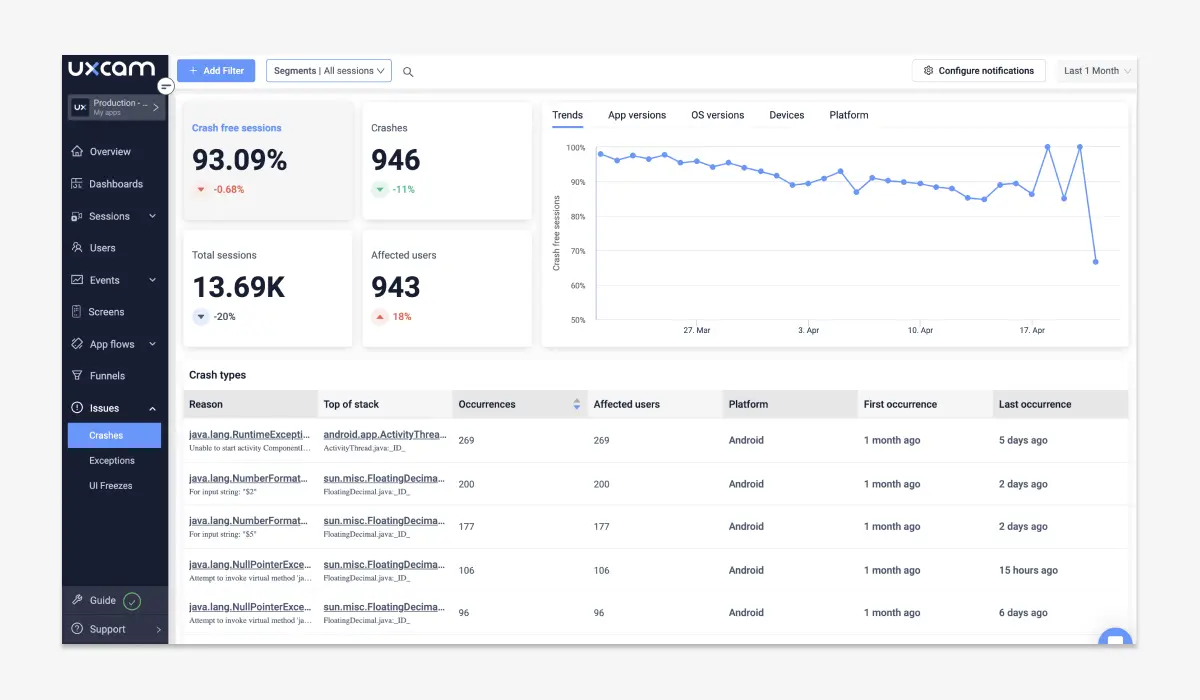
You’ll also be able to see the basic statistics about the issues happening in your app, check trends to understand if the number of problems is increasing or decreasing over time, and verify which devices your app is having issues on.
Sign up for free today to see the magic for yourself!
You might also be interested in these;
How to Find Bugs in Mobile Applications
React Native Crashlytics - Step-by-Step Integration Guide
Best Practices for Error Handling in React Applications
Flutter Crashlytics - Integration Guide for Your Mobile Apps
6 Best Error Monitoring Software Tools To Analyze App Crashes
AUTHOR

Tope Longe
Product Analytics Expert
Ardent technophile exploring the world of mobile app product management at UXCam.
What’s UXCam?
Related articles
Curated List
Top 19 Mobile App Analytics Tools in 2026
Discover the top mobile analytics tools in 2026. Compare features, pricing, and reviews to choose the right platform for app tracking, behavioral insights, and data-driven...

Jonas Kurzweg
Product Analytics Expert
App Analytics
Mobile App Tracking: Practical Guide & Best Tools [2026]
The best tracking tools for mobile...

Jonas Kurzweg
Product Analytics Expert
App Analytics
Best Android App Analytics Tools in 2026
Discover the top 8 Android analytics including UXCam, Firebase, and Flurry Analytics. Compare features, pricing, and platforms...

Annemarie Bufe
Product Analytics Expert


